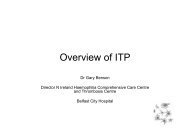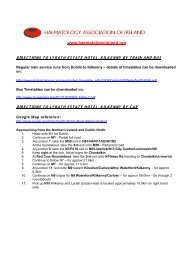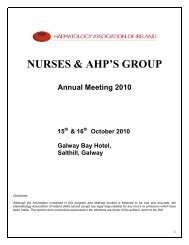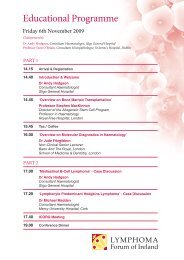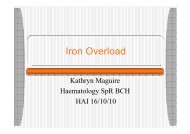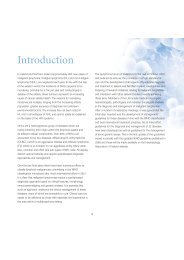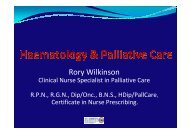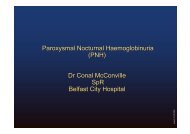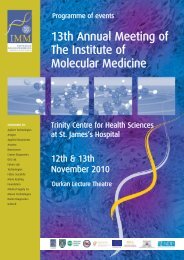Guidelines on Diagnosis and Treatment of Malignant Lymphomas
Guidelines on Diagnosis and Treatment of Malignant Lymphomas
Guidelines on Diagnosis and Treatment of Malignant Lymphomas
You also want an ePaper? Increase the reach of your titles
YUMPU automatically turns print PDFs into web optimized ePapers that Google loves.
Patients with primary refractory disease or partial resp<strong>on</strong>se to<br />
therapy will need to have treatment intensified. Switching to<br />
BEACOPP-14 is recommended in patients with positive PET after<br />
2 cycles <strong>of</strong> ABVD. If PET is negative after 4 cycles c<strong>on</strong>solidate<br />
with 2 further cycles <strong>of</strong> BEACOPP-14. If PET remains positive<br />
salvage treatment followed by autologous stem cell transplanti<strong>on</strong><br />
should be c<strong>on</strong>sidered.<br />
Follow-Up<br />
Clinical:<br />
History <strong>and</strong> physical examinati<strong>on</strong> every three m<strong>on</strong>ths for <strong>on</strong>e year,<br />
every six m<strong>on</strong>ths for three years, then yearly.<br />
Laboratory:<br />
FBC <strong>and</strong> biochemistry al<strong>on</strong>g with clinical evaluati<strong>on</strong>s for up to two<br />
years. Thyroid functi<strong>on</strong> to be assessed at <strong>on</strong>e year then yearly for<br />
life in patients who have had neck or mediastinal irradiati<strong>on</strong>.<br />
Diagnostic imaging:<br />
Chest radiographs, al<strong>on</strong>g with clinical evaluati<strong>on</strong>s up to two years.<br />
Then as indicated. CT scan to define initial remissi<strong>on</strong> status <strong>and</strong><br />
then, if necessary, to m<strong>on</strong>itor residual abnormalities if chest<br />
radiograph does not suffice. PET scan is not needed at the end <strong>of</strong><br />
treatment if interim scan is negative.<br />
Mammography or other suitable screening should be <strong>of</strong>fered in a<br />
structured fashi<strong>on</strong> to young women given chest irradiati<strong>on</strong> before<br />
age 25 years.<br />
<strong>Treatment</strong> at Relapse<br />
Salvage chemotherapy (eg ICE) followed by autologous<br />
transplant should be c<strong>on</strong>sidered st<strong>and</strong>ard therapy for all patients<br />
with an adequate performance status previously treated with<br />
chemotherapy including those with late relapse. Early referral to a<br />
centre with the capacity to deliver such therapy is m<strong>and</strong>atory.<br />
Patients should be scheduled for harvest after 2 cycles <strong>of</strong> salvage<br />
chemotherapy. A further course <strong>of</strong> salvage chemotherapy is then<br />
administered prior to high dose chemotherapy <strong>and</strong> autologous<br />
stem cell rescue.<br />
Repeat CT scan post 2 cycles <strong>of</strong> salvage chemotherapy <strong>and</strong> PET<br />
scan after third <strong>and</strong> final cycle. CT scan after sec<strong>on</strong>d cycle is to<br />
c<strong>on</strong>firm resp<strong>on</strong>sive disease <strong>and</strong> PET scan after third cycle is to<br />
c<strong>on</strong>firm CR. Patients who are PET positive at this stage should be<br />
c<strong>on</strong>sidered for further salvage therapy with Gemcitabine based<br />
treatment or allogeneic transplantati<strong>on</strong>.<br />
In patients unfit for transplant palliative chemotherapy <strong>and</strong><br />
radiotherapy can be administered as required. Rituximab may<br />
be a useful adjunct in CD20 positive cases.<br />
Selected References:<br />
PET for resp<strong>on</strong>se adapted in advanced Hodgkin’s Lymphoma<br />
(RATHL) – NCRI<br />
VEPEMB in elderly Hodgkin’s lymphoma patients. Results from<br />
Intergruppo Italiano Linfomi (IIL) study. Levis,A et al. Annals <strong>of</strong><br />
Oncology 15: 123-128, 2004.<br />
G-CSF is not necessary to maintain over 99% dose-intensity<br />
with ABVD in treatment <strong>of</strong> Hodgkin Lymphoma: low toxicity <strong>and</strong><br />
excellent outcome in a 10-year analysis. Evens AM et al. British<br />
Journal <strong>of</strong> Haematology 2007 137, 545-552.<br />
62



